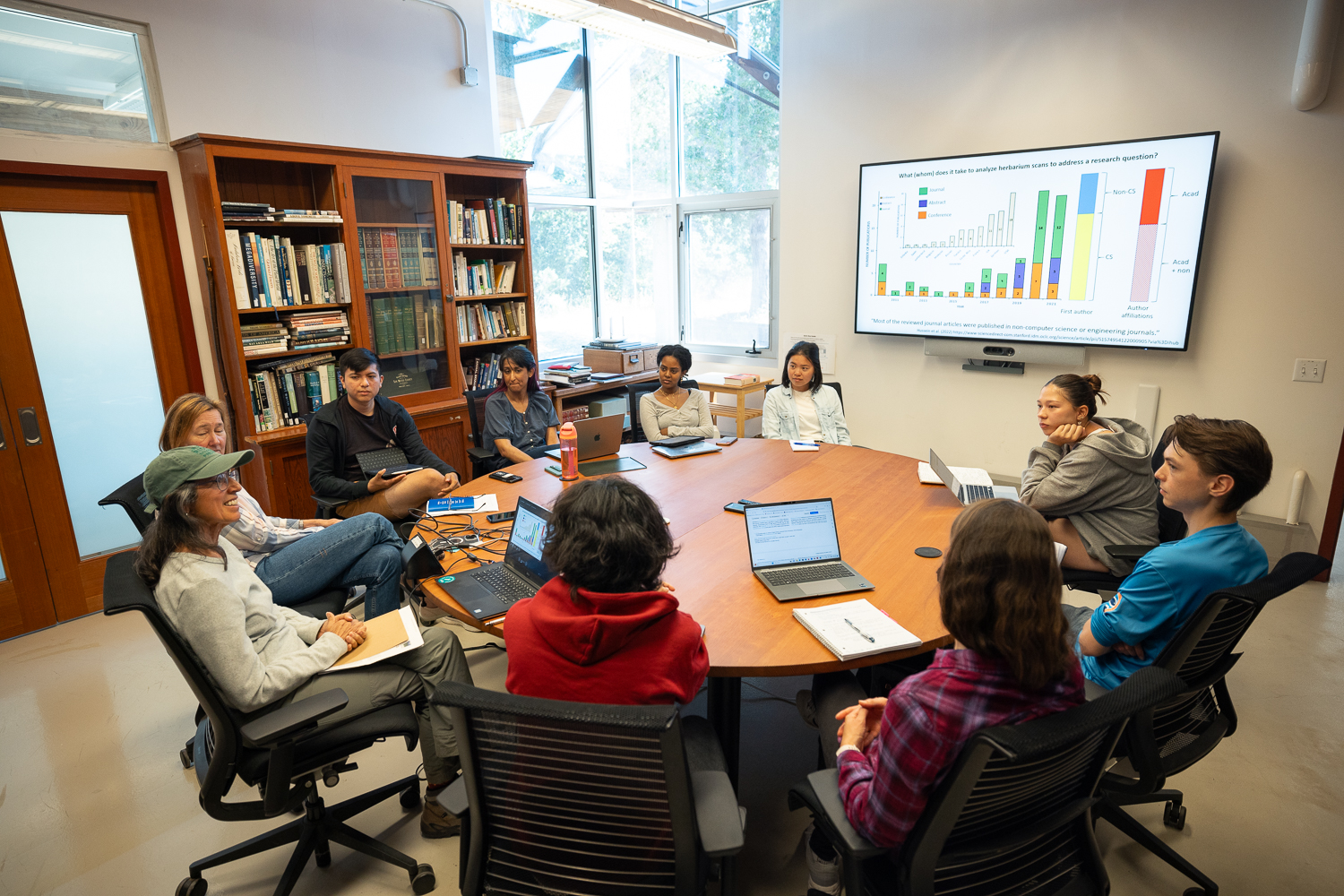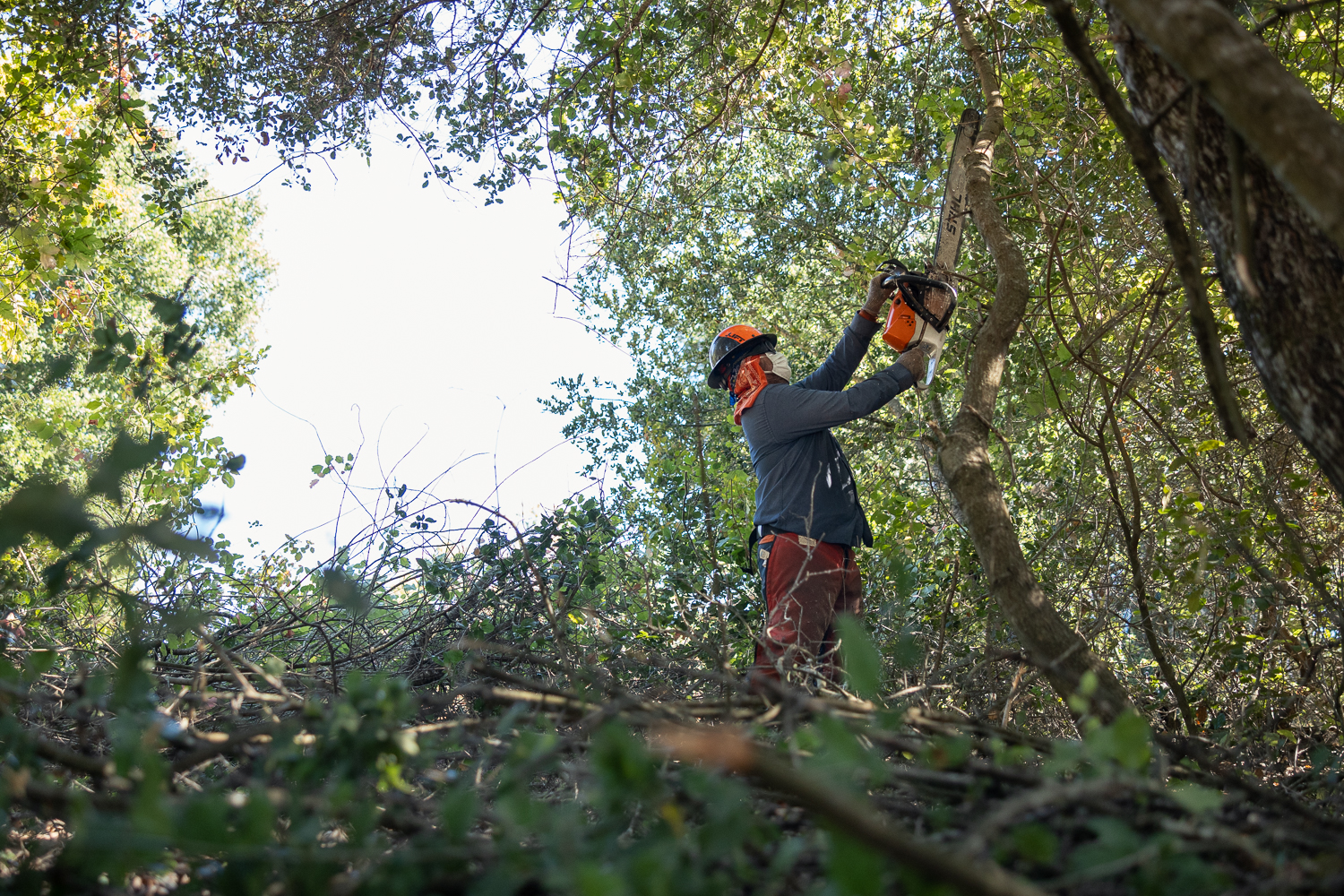Jasper Ridge student summer projects highlight the preserve’s past and future
Undergraduate fellows and interns took part in forward-thinking projects at Stanford’s Jasper Ridge Biological Preserve this summer, including digitizing the Oakmead Herbarium and testing a wildfire management plan.

Danny Argudo works on the digitization of a pressed plant collection from Jasper Ridge’s Oakmead Herbarium. (Image credit: Andrew Brodhead)
Danny Argudo spent his summer learning, among other things, to wield a pizza peel.
He wasn’t pulling pies from an oven, though. Instead, Argudo, a sophomore and intern at Jasper Ridge Biological Preserve through the Stanford Summer Fellows Program, used the giant spatula to draw stacks of folders from a wall of cabinets at the preserve’s Oakmead Herbarium. Alongside herbarium staff and volunteers, Argudo helped photograph the pressed plant specimens in each folder and upload the images to CCH2, the Consortium of California Herbaria’s public database.
By the time they’re through, they’ll have made images of Oakmead Herbarium’s 6,000 specimens accessible to any plant-curious person with an internet connection.
Indoors and out, Jasper Ridge, which is part of the Stanford School of Humanities and Sciences, spent its summer investing in the future. While this project preserves the herbarium’s plant collection in digital form, beyond the herbarium walls, staff, interns, and workers were fortifying the land itself by implementing and testing a wildfire management plan near the preserve’s main entrance.
Both projects also aim to strengthen Jasper Ridge’s relationships with the world outside the Farm – the former by offering a trove of data to the public and the latter by reducing fire risk to neighbors. And both provide hands-on experience in botany and ecology to Stanford undergraduates, unlocking new appreciations of local ecosystems and interdisciplinary ideas of how to study and protect them.
“In my experience, whenever you’re an intern, a lot of times it’s stagnant. Sometimes you’re just observing or getting coffee,” said senior Mary Ghebreselassie, an international relations major and Jasper Ridge stewardship intern. But her work at the preserve has felt different. “They’ve been really intentional about making sure we have hands-on experience and that, at the end, we have something to show for ourselves.”
Seeing history
Inevitably, photographing 6,000 specimens one by one gets tedious.
“Sometimes you’re sitting there thinking, ‘How many do we have to go?’” joked Dawn Neisser, ’79, a longtime Jasper Ridge docent and herbarium volunteer. She hopes to finish in the next few months. “We’ll be happy when we get through all the cabinets.”
But it’s also satisfying, she said. Oakmead Herbarium houses specimens of more than 830 vascular plant species found at Jasper Ridge, or about 10% of all those native or growing wild in California – an enormous diversity for a preserve just under 1,200 acres in area.
“From a plant nerd point of view, I just stop and go, ‘Oh my god, look at that flower!’” said Neisser. “I’m enjoying learning about all of this as I’m going through it.”
Argudo concurs. “I wasn’t much of a plant lover before, but now, just getting to see all the species – I didn’t know there could be that many!” he said. So far, his favorite in the collection is Wyethia angustifolia, or narrowleaf mule ears, because digitizing the specimen allowed him to see the fuzzy, white hairs of the leaves in high detail.

Danny Argudo’s favorite pressing in the collection, Wyethia angustifolia, or narrowleaf mule ears. (Image credit: Courtesy of Nona Chiariello)
“I’m seeing specimens that predate a hundred years ago,” said Argudo. The oldest dates to the mid-1800s. “It’s really like seeing history.”
The experience has also provided an opportunity to use his existing skills. Many pressings include paper maps with hand-drawn markers indicating where the specimen was collected. As a prospective computer science major, Argudo is investigating machine learning to translate those points into GPS coordinates, providing more precise locational information to scientists looking to collect additional specimens, replant struggling species, or track a plant’s presence in a place over time.
Bringing botany into the digital age
Argudo isn’t the only one with new ideas about what digitization could do. On an afternoon in August, he joined a group of Jasper Ridge staff, students, docents, and volunteers – including another Stanford Summer Fellow, sophomore Eugene Hong – to discuss the digitization project. The conversation bears special relevance today as collections throughout California and around the world undertake similar efforts.

Nona Chiariello and Dawn Neisser lead a meeting of the summer fellows where they discuss pragmatic and inventive destinies for their digitized plant pressing collection. (Image credit: Andrew Brodhead)
Having access to so many collections at once, attendees reasoned, should allow scientists to prioritize understudied plants, especially those threatened or endangered. Historically, collectors have often focused on the biggest, showiest, and most easily reachable plants, noted Paul Markley, a second-year PhD student in the lab of Barnabas Daru, assistant professor of biology.
“If it’s a really tiny plant that has a little, tiny flower, people are just going to walk right past it,” he said.
“Or on it!” Neisser chimed in.
Opening up more plant data could fuel original research in ecology and natural history. In the Oakmead Herbarium, for instance, Neisser noted a specimen with a squiggly white stripe on one leaf – possible damage from a leaf miner insect. If so, that specimen confirms a relationship between the plant and the leaf miner at a certain time and place. Putting millions of specimens online could let ecologists more closely study how and why relationships like this changed in the past – and potentially suggest how they might change in the future.
Digitizing plant specimens also puts artificial intelligence on the table, mused Nona Chiariello, the staff scientist at Jasper Ridge overseeing the project. If there were AI programs capable of identifying and categorizing digital plant specimens en masse, they could correct tens of thousands of mislabeled and unidentified specimens around the world and dramatically speed up the processing of new ones.
The group was skeptical of this possibility, given the complexity of the plant kingdom and the need for interdisciplinary collaboration. But Chiariello encouraged those present to consider any and all new perspectives, even those that appear challenging.
“The possibilities that I see are really constrained by my experience, so I try not to assume that I can see that far ahead,” she said. “My goal has been to protect Jasper Ridge. If the herbarium provides resources, and digitization amplifies those opportunities, that will help.”
A fiery balancing act
Out in the field, another type of protection has commenced.
A stone’s throw to the north of Jasper Ridge’s main entrance, an old coast live oak log hugs the ground between its standing relatives. Dead and dry, it would make a fine meal for a wildfire.
“That’s a lot of fuel,” admitted Sheena Sidhu, a stewardship scientist at the preserve. This summer, Sidhu has overseen a wildfire resiliency project that has included research opportunities for Jasper Ridge stewardship interns. Around her, the air thrummed with the din of chainsaws as a crew of workers thinned out dry brush.

Sheena Sidhu points to the woodrat house that has been left intact as part of the preserve’s wildfire management plan, which considers the needs and safety of humans and wildlife. (Image credit: Andrew Brodhead)
The log, however, will stay. White flagging tape waved from the branches around it, telling the crew to leave it alone.
“It’s great habitat,” she explained. She pointed to a refrigerator-sized jumble of sticks and branches heaped over the log’s middle, something an untrained eye might pass over. “See that pile of twigs? That’s actually a woodrat nest.”
This balancing act – between removing dry, flammable plant matter and preserving valuable habitat features – comes up constantly as staff, students, and contractors implement Stanford’s wildfire management plan at Jasper Ridge. Hand crews will thin forested areas and cut away low-growing brush and tree limbs, leaving less fuel to burn and making it harder for fire to leap to the canopy. A variety of fuel reduction treatments will take place across almost 100 acres along the preserve’s southern and western borders – areas of high priority because they abut the town of Portola Valley as well as Sand Hill Road, a fire evacuation route.
But as a biological preserve, Jasper Ridge must continue to be a good host to wildlife as well. Crews will minimize removal of ecologically critical species like oaks and valuable habitat features, like the fallen log. Sidhu has also conferred with other Jasper Ridge scientists about how to reduce disturbance to long-term research projects, like the ant survey that’s been going on for 30 years.
Inevitably, though, treatment will leave a mark. The landscape will look bare and stark at first. But within a year or so of treatment, Sidhu assured, native plants will start to come back. “It will look less like it just got a haircut,” she said.
Keeping a watchful eye
Under Sidhu’s guidance, Ghebreselassie and Kiara Fufunan, a junior Earth systems major, were Jasper Ridge’s inaugural stewardship interns. Outfitted in full-body jumpsuits to guard against poison oak, they staked out 30-by-30-meter plots within the test zone and outside it. There, they recorded plant and mammal species, canopy coverage, tree diameter, habitat features, and more before the crew started removing brush, and the same data will be recorded once it finishes. Future interns will monitor these plots every summer to track the impacts of brush removal on the ecosystem, informing tweaks to fire management down the road.
The internship also included individual projects related to fire management. For hers, Ghebreselassie chose to design a website for the preserve about the traditional fire management techniques that Indigenous peoples have practiced on lands near Jasper Ridge for centuries. Meanwhile, Fufunan monitored butterflies to see if their populations change as the fuel reduction impacts their habitats.

Arborists thinned out forested areas of the preserve to reduce possible fire fuel and make it harder for fire to jump between ground and branches. (Image credit: Andrew Brodhead)
Both hope to stay involved at the preserve.
“Being able to work in such a dynamic environment and learning how it changes over time is really cool,” said Fufunan. “I’d love to be able to come back and see the progress that we’ve made or how the preserve has changed, and maybe even do some more research here.”
A resurgence of interest
For Chiariello, the interns’ enthusiasm sparks hope that the fields of botany, taxonomy, and ecology will stay strong into the future.
“We tend to think of taxonomists as being these crusty old people and of herbarium people as living among the mothballs,” she said. But these days, she sees “a resurgence of interest among young people in the satisfaction of knowing what you’re seeing outside, and the idea that you might be able to help protect or restore it.”
This summer’s crop of Jasper Ridge interns certainly proved her point.
“Even though I’m an aspiring physician and I want to treat and heal people, this work is similar in that we’re treating and healing the land,” said Ghebreselassie. “I’m excited to bring those two sides together.”
“Learning as much as possible about the land where I study is really important to me,” said Fufunan. “I can name trees I see when I walk by. I think that’s really cool.”